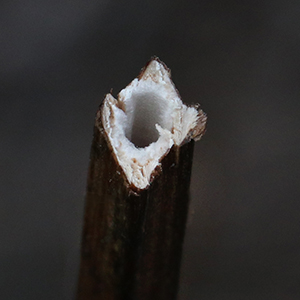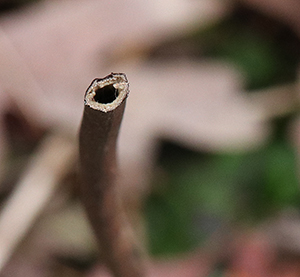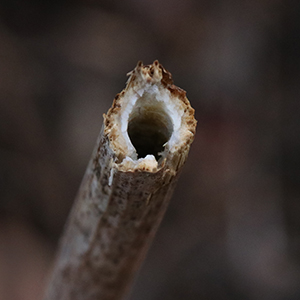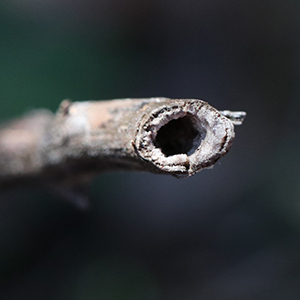Provide Nesting Habitat for Native Bees Through Plant Stems in Your Garden
go.ncsu.edu/readext?857307
en Español / em Português
El inglés es el idioma de control de esta página. En la medida en que haya algún conflicto entre la traducción al inglés y la traducción, el inglés prevalece.
Al hacer clic en el enlace de traducción se activa un servicio de traducción gratuito para convertir la página al español. Al igual que con cualquier traducción por Internet, la conversión no es sensible al contexto y puede que no traduzca el texto en su significado original. NC State Extension no garantiza la exactitud del texto traducido. Por favor, tenga en cuenta que algunas aplicaciones y/o servicios pueden no funcionar como se espera cuando se traducen.
Português
Inglês é o idioma de controle desta página. Na medida que haja algum conflito entre o texto original em Inglês e a tradução, o Inglês prevalece.
Ao clicar no link de tradução, um serviço gratuito de tradução será ativado para converter a página para o Português. Como em qualquer tradução pela internet, a conversão não é sensivel ao contexto e pode não ocorrer a tradução para o significado orginal. O serviço de Extensão da Carolina do Norte (NC State Extension) não garante a exatidão do texto traduzido. Por favor, observe que algumas funções ou serviços podem não funcionar como esperado após a tradução.
English
English is the controlling language of this page. To the extent there is any conflict between the English text and the translation, English controls.
Clicking on the translation link activates a free translation service to convert the page to Spanish. As with any Internet translation, the conversion is not context-sensitive and may not translate the text to its original meaning. NC State Extension does not guarantee the accuracy of the translated text. Please note that some applications and/or services may not function as expected when translated.
Collapse ▲By the time springtime rolls around many folks are itching to get back into their gardens and start cleaning up in preparation for a new season of blooms. Hopefully last year’s perennials have been left standing through the winter to provide food and shelter for wildlife (and beauty for humans!). In my earlier article on Fall Chores in the Pollinator Garden I discuss the benefits of leaving the leaves and saving the stems in the fall.
Planting flowers for pollinators and other wildlife is an important first step in their conservation, but how you maintain your garden after planting has an impact on the benefits it provides. Most people primarily focus on gardening from spring through fall and don’t think about the off-season but the availability of nesting and overwintering habitat has a huge impact on the populations of pollinators and other insects.
In North Carolina, we have about 560 species of native bees, most of them solitary. Solitary bees select and modify nesting sites and collect pollen to provision the nest on their own. About 75% of these bees nest in tunnels that they construct in the ground. About 25% of North Carolina native bees nest in cavities. Solitary species will nest in cavities in plant stems and wood (often in tunnels made by other insects such as beetles). Social bees such as bumble bees will nest in larger cavities like abandoned rodent burrows and even human-made structures like brush piles, rock piles, bluebird houses, and watering cans!

Solitary ground nesting Andrenid mining bee female provisioning her nest in early spring. Mining bees are important pollinators of early flowering crops. Photo by Debbie Roos.

Bumble bees are cavity nesters and can be very opportunistic in where they choose to construct their nests. This nest was created using animal hair and dried grasses in the “cavity” of a cat bed in a barn! Photo by Debbie Roos.
A recent NC State Extension publication provides details on North Carolina’s stem- and wood-nesting bees. These bees fit under three families:
Family Megachilidae – includes mason bees (22 species in North Carolina), leafcutting bees (37 species in North Carolina, but some nest in cavities or soil), resin bees (10 species in North Carolina), wool carder bees (three species in North Carolina, two of which are introduced). This family also includes 23 species of cuckoo bees which are kleptoparasites, laying their eggs in other bees’ nests!
Family Colletidae – includes yellow-faced bees (13 species in North Carolina) and also cellophane bees (25 species in North Carolina) which nest in the ground.
Family Apidae – includes small carpenter bees (six species in North Carolina) which nest in stems with a soft, pithy center where they can hollow out the stem and use the excavated plant material to build their nest. The Apidae family also includes bumble bees, honey bees, and large carpenter bees, but most of these do not nest in plant stems (large carpenter bees will sometimes create nests in larger pithy stems).
Another NC State Extension publication, The Bees of North Carolina: an Identification Guide, provides details on all the native bees of the state with excellent photos and helpful ID tips.

Leafcutter bee foraging on wild indigo in the spring. Leafcutter bees carry pollen in the hairs on the underside of their abdomen. They are one of two primary pollinators of wild indigo (along with bumble bees). Photo by Debbie Roos.

Leafcutter bees cut sections of leaves from shrubs and other plants to line their nest, often made in hollow plant stems. I have also seen leafcutter bees nest in water hoses! Photo by Debbie Roos.

Small carpenter bee on coneflower. Photo by Debbie Roos.

Orchard mason bee on fernleaf phacelia in early spring. Photo by Debbie Roos.
Other insects and arthropods besides bees will also seek out hollow plant stems for nesting and overwintering, including solitary wasps, stem-boring moths, earwigs, spiders, and other insects.
If you really want to help provide habitat for bees and other pollinators, then it’s important to think beyond flowers and include nesting and overwintering habitat in your garden and landscape.
Since approximately 100 species of bees in North Carolina nest in stems and wood, it’s helpful to understand a little about their life cycle to be able to provide what they need through stem management in the garden. How and when you cut back your plants can have an impact on our stem nesting bees.
General Life Cycle of Stem Nesting Bees
Stem-nesting bees start emerging from their overwintering nests in the spring, and each family has its own timetable for emergence. The earliest emerging stem-nesting bees are the mason bees which start emerging in early March. Small resin bees (Heriades and Hoplitis spp.) start emerging in April. Leafcutter bees (Megachile spp.), yellow-faced bees (Hylaeus spp.), and carder bees (Anthidium spp.) usually start emerging in May. These are rough estimates that are dependent on the weather – I saw my first leafcutter bee in mid-April this year, foraging on wild indigo.

Small carpenter bee nesting in sumac stem. Photo by Heather Holm.

Small resin bee nesting in a stem. Photo by Molly Jacobson.
Once the bees emerge they start collecting pollen and looking for nesting sites. Bees pack pollen mixed with nectar into the stems and lay eggs, creating separate chambers within the stem divided by partitions of mud or chewed plant material. The larvae hatch and consume the “bee bread” and develop throughout the year. They hibernate during the winter and emerge the following spring.
Timing of Plant Cut-Back
All the plants from the previous year were left intact all through the winter, as is. This provides a beautiful landscape of dried seedheads, stems, and grasses through the winter and more importantly, food and shelter for pollinators and other wildlife.
I wait until late winter/early spring (late February/March) to start cutting plants back. I aim to have at least some stems cut back by early March when our earliest emerging stem-nesting bees, the mason bees, start looking for nesting sites.
I have learned from experience that there are at least a couple of species that benefit from fall cutback: the very tall and very stout-stemmed cup plant (Silphium perfoliatum) and field thistle (Cirsium discolor). Because their stems are so heavy they can get blown over in the winter, especially if we get a little snow or rain-saturated soils, so these are examples of species that would benefit from being cut back in the late fall after the birds have feasted on their seeds.

Very tall and stout stems like those of cup plant shown here, can get knocked down in the winter due to their heaviness. Stems laying on the ground will not be attractive nesting sites for bees. Such stems would benefit from being cut back to about 24 inches in the fall. Photo by Debbie Roos.
Because I manage a large garden, we can still be cutting plants back well into April. That’s okay since many species like leafcutting bees, yellow-faced bees, and wool carder bees have probably not emerged yet from their winter nest but ideally I aim to have most of the cut-back completed by early April so that nesting sites are available to any emerging bees. This doesn’t always happen because sometimes we get diverted by other tasks such as weeding!

Carolina anole on cut fennel stem. Photo by Debbie Roos.

This photo of tall tickseed shows stems cut the previous year alongside stems that are about to be cut in early spring. The stems cut last year could house nesting bees that have not yet emerged. Photo by Debbie Roos.
How and What to Cut Back
Because we don’t yet know all the species that are attractive to our stem nesting bees, I find it easiest to cut everything back so that it could be a potential nesting site. We cut plant stems back to a height of 8-24 inches. Most stem-nesting insects require hollow stems, but a few species of bees can utilize pithy stems which have a soft center that can be hollowed out by the bee. Only a few types of bees are capable of doing this (carpenter bees, some leafcutter bees, small resin bees) – most species require a stem that is already hollow.

Overwintered, intact rattlesnake master plant in early spring. Photo by Debbie Roos.

Rattlesnake master after stems are cut back to about 18 inches in early spring. Removing the dead leaves from the previous season also brings sunlight to the new growth. Photo by Debbie Roos.

Close-up of hollow rattlesnake master stems after cutting. Photo by Debbie Roos.
Once you cut the stems back, that’s it, your work is done! The cut stems may or may not provide nesting sites for bees but in any event they will eventually naturally decompose in the garden. By early summer the stems you just cut will be camouflaged by the new growth of the plant.
My Pollinator Paradise Garden in Pittsboro has over 225 different species of plants. This includes trees, shrubs, herbaceous perennials, vines, and grasses of all different sizes. This diversity is helpful because the body size of stem-nesting bees ranges from 3-25 mm (1/10-1 inch) depending on the species. Different size bees require different size stems so it’s good to have stems ranging from 2-15 mm (1/8-5/8 inch) in diameter for them to nest in. Fun fact: the largest stem nesting bee in North Carolina is the giant resin bee, a non-native Megachilid bee that was accidentally introduced to the U.S. in 1994.

Giant resin bee on culver’s root. Photo by Debbie Roos.
Having stems that range in diameter from 1/8-5/8 inch will also accommodate the solitary wasp species that nest in plant stems. Species such as grass-carrying wasps, potter wasps, mason wasps, and square-headed wasps help with pollination and also pest control as they provision their nests with caterpillars, grasshoppers, and other insects to rear their young.

Mason wasp foraging on yellow passionflower. This solitary wasp nests in hollow stems. Photo by Debbie Roos.
North Carolina State University is currently conducting a research study looking at how garden management practices can impact bee nesting, by studying which species of bees utilize which species of plants and when they emerge. The study is conducted by Extension Master Gardener Volunteers in several counties under the project leadership of Elsa Youngsteadt and Hannah Levenson at NC State. My Pollinator Paradise Garden is one of the research sites.

Chatham County Master Gardener Volunteer Kathy Morris harvests bronze fennel stems in early spring at the Pollinator Paradise Demo Garden. This garden is one of the research sites for a NCSU study. Photo by Debbie Roos.
I have been documenting which plant species have hollow stems and which have pithy stems in my pollinator garden. You can see the full list of species included in my garden on my website. Below are photos of some examples of what I have found. Some species may have both hollow and pithy stems within the same clump and this is noted in the table below.
Some Plants with Hollow Stems
 |
Anise hyssop Agastache foeniculum |
 |
Bluestar Amsonia spp. |
 |
Tall anemone Anemone virginiana |
 |
Milkweed Asclepias spp. |
 |
Wild indigo Baptisia spp. Hollow stems but they usually break off |
 |
Field thistle Cirsium discolor |
 |
Tall tickseed Coreopsis tripteris |
 |
Rattlesnake master Eryngium yuccifolium |
 |
Joe-pye weed Eutrochium dubium |
 |
Bronze fennel Foeniculum rubrum |
 |
Red rose mallow Hibiscus coccineus |
 |
Seashore mallow Kosteletzkya virginica |
 |
Cardinal flower Lobelia cardinalis |
 |
Bee balm Monarda fistulosa |
 |
Pink muhly grass Muhlenbergia capillaris |
 |
Switchgrass Panicum virgatum |
 |
Carolina phlox Phlox carolina Some stems are pithy |
 |
Orange coneflower Rudbeckia fulgida Some stems are pithy |
 |
Stonecrop Sedum spp.
|
 |
Cup plant Silphium perfoliatum Some stems are pithy |
 |
Skunk meadowrue Thalictrum revolutum |
 |
Carolina lupine Thermopsis villosa |
 |
Culver’s root Veronicastrum virginicum |
 |
Golden alexander Zizia aurea |
Some Plants with Pithy Stems
 |
Purple coneflower Echinacea purpurea |
 |
Oxeye daisy Heliopsis helianthoides |
 |
Blazing star Liatris spp. |
 |
Spotted horsemint Monarda punctata |
 |
Wild quinine Parthenium integrifolium
|
 |
Obedient plant Physostegia virginiana |
 |
Mountain mint Pycnanthemum spp. |
 |
Staghorn sumac Rhus typhina |
 |
Green-headed coneflower Rudbeckia laciniata |
 |
Hoary skullcap Scutelleria incana |
 |
Goldenrod Solidago spp. |
 |
Aster Symphyotrichum spp. |
 |
Crownbeard Verbesina occidentalis |
 |
Ironweed Vernonia spp. |
Resources for Further Learning
- Pollinator Paradise Demonstration Garden – NC State Extension
- Fall Chores in the Pollinator Garden – NC State Extension
- The Bees of North Carolina: an Identification Guide – NC State Extension
- How to Manage a Successful Bee Hotel – NC State Extension
- How to Manage a Successful Bee Hotel: Meet the Residents – NC State Extension
- Growing Knowledge to Protect Pollinators – NC State Extension
- Nesting and Overwintering Habitat for Pollinators and Other Beneficial Insects – Xerces Society
- Nesting Resources – Xerces Society
- Sam Droege Phenology of Bee Genera for mid-Atlantic States


